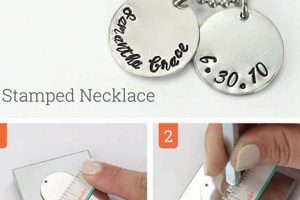The creation of personalized decorative signage, often utilizing readily available materials and tools, is a common practice for celebrations, events, and personal expression. Examples include fabric pennants strung together for a birthday, paper cutouts arranged to spell a message for a graduation, or painted canvas used to promote a cause at a rally.
The significance of such handcrafted displays lies in their affordability, adaptability, and potential for unique customization. Historically, homemade flags and banners served as crucial methods of communication and identification, predating mass-produced alternatives. Today, these creations provide opportunities for artistic exploration and cost-effective decoration, fostering a sense of ownership and personalization absent from commercially produced options.
The subsequent discussion will delve into various techniques for constructing personalized signage, exploring different materials suitable for various environments, and offering practical advice for design and assembly, ensuring a visually appealing and durable finished product.
Tips for Creating Effective Personalized Signage
The following suggestions provide guidance for achieving high-quality, visually appealing personalized signage for various applications.
Tip 1: Material Selection: Prioritize materials appropriate for the intended environment. Outdoor displays require weather-resistant options like vinyl or treated fabric. Indoor applications allow for lighter materials such as paper or felt. Consider durability and longevity during selection.
Tip 2: Legibility is Paramount: Ensure clear and easily readable lettering. Select fonts that are simple and uncluttered, and maintain sufficient contrast between the text and background colors. Test readability from a distance to confirm effectiveness.
Tip 3: Size and Scale Considerations: Determine appropriate dimensions relative to the viewing distance and surrounding environment. A display intended for a large auditorium will necessitate larger lettering and overall dimensions compared to one designed for a smaller room.
Tip 4: Secure and Stable Mounting: Employ robust and appropriate mounting methods to prevent damage or displacement. Consider factors such as wind resistance, weight distribution, and surface compatibility when selecting hanging hardware or adhesives.
Tip 5: Design for Visual Harmony: Create a cohesive and balanced aesthetic. Limit the number of fonts and colors used to avoid visual clutter. Incorporate consistent spacing and alignment to enhance visual appeal.
Tip 6: Pre-Assembly Planning: Develop a detailed layout and assembly plan prior to commencing construction. This ensures accurate alignment, minimizes errors, and streamlines the overall process.
These guidelines ensure a professional and impactful presentation, maximizing the effectiveness of the personalized signage.
The article will continue to explore more advanced techniques and creative applications of personalized display design.
1. Material Durability
Material durability constitutes a critical factor in the creation of personalized signage. The longevity and resilience of the chosen material directly impact the suitability and lifespan of the finished display, particularly in variable environmental conditions. The selection process must, therefore, prioritize materials engineered to withstand intended usage and external factors.
- Environmental Resistance
Different environments demand varying degrees of material resilience. Outdoor displays necessitate resistance to UV radiation, moisture, and temperature fluctuations. For instance, a polyvinyl chloride (PVC) banner exhibits superior weather resistance compared to a paper banner. Indoor applications, conversely, may permit the use of less robust materials, provided the selected option remains resistant to tearing or fading under typical indoor conditions.
- Physical Stress and Handling
The capacity to withstand physical stress associated with handling, installation, and storage is pivotal. A fabric banner designed for repeated use requires reinforced seams and tear-resistant fabric. A paper option, inherently more fragile, may necessitate lamination or other protective measures to mitigate damage during handling. Durability ensures extended usability and reduces replacement frequency.
- Longevity and Intended Lifespan
The anticipated lifespan of the signage should directly inform material selection. A permanent display warrants long-lasting materials such as treated canvas or durable plastics. For temporary applications, less durable and more cost-effective options, like paper or lightweight fabrics, may prove sufficient. Aligning material selection with intended lifespan optimizes resource utilization and cost-effectiveness.
- Maintenance Requirements
Material choice affects maintenance needs. Some materials, like vinyl, are easily cleaned with a damp cloth. Others, such as paper, may require specialized cleaning methods or be inherently difficult to clean without causing damage. The practicality of cleaning and maintaining the finished sign should factor into the initial material selection process to ensure long-term aesthetic appeal and functionality.
In summary, the selection of materials for personalized signage demands careful consideration of environmental factors, physical stress, lifespan expectations, and maintenance requirements. By prioritizing material durability, creators can ensure that their personalized signage remains visually appealing, functionally effective, and long-lasting, fulfilling its intended purpose in the desired environment.
2. Lettering Legibility
Lettering legibility is a paramount consideration in the creation of effective handcrafted signage. The success of conveying a message hinges directly on the clarity and ease with which the lettering can be deciphered. A well-designed display with illegible lettering fails to serve its primary purpose, rendering the visual effort inconsequential.
- Font Selection
The choice of font significantly impacts legibility. Simple, sans-serif fonts are generally easier to read at a distance than ornate, stylized fonts. For instance, a clear font like Arial or Helvetica is more suitable for outdoor signage than a script font with elaborate flourishes. The selected font should maintain consistent stroke weight and spacing to avoid visual clutter and improve readability.
- Contrast and Color
Adequate contrast between the lettering and the background is crucial for legibility. A dark color on a light background, or vice versa, provides optimal visual separation. Insufficient contrast, such as similar shades of blue, can make the letters blend
into the background, rendering the message difficult to read. Consider the viewing environment and potential lighting conditions when selecting color combinations. - Letter Spacing and Kerning
Consistent and appropriate letter spacing, known as kerning, contributes significantly to legibility. Overly compressed letters appear crowded and are difficult to distinguish, while excessive spacing can disrupt word flow. Adjusting the space between specific letter pairs, such as “AV” or “WA,” can improve visual balance and overall readability. Attention to kerning is particularly important when working with custom fonts or creating unique letter arrangements.
- Size and Viewing Distance
The size of the lettering must be proportional to the intended viewing distance. A small display intended for close-up viewing can utilize smaller fonts, while a large banner designed to be seen from a distance requires larger lettering. Empirical formulas exist to calculate the minimum letter height needed for a given viewing distance, ensuring that the message remains legible even from afar. Accurate size determination is crucial for effective communication, especially in outdoor or large venue settings.
The interplay of font selection, contrast, spacing, and size collectively determines the legibility of any display. When creating handcrafted signage, meticulous attention to these details ensures that the intended message is conveyed effectively and efficiently, maximizing the impact and utility of the finished product. Without a strong focus on legibility, the entire creative endeavor risks becoming a visual exercise in futility.
3. Size Proportionality
Size proportionality, within the context of handcrafted signage, refers to the relationship between the dimensions of the display, the size of its constituent elements (lettering, images, etc.), and the distance from which it is intended to be viewed. This relationship is not arbitrary; it dictates the effectiveness of communication. Insufficiently large lettering on a substantial background, for instance, renders the message illegible at a distance, negating the purpose of the signage. Conversely, excessively large elements on a small display create visual clutter and reduce overall clarity. The cause-and-effect dynamic is straightforward: inaccurate proportionality impairs communication; accurate proportionality enhances it.
The importance of size proportionality as a component of handcrafted signage stems from its direct impact on audience engagement and comprehension. Consider a promotional banner intended for display at a public event. If the lettering is too small to be read from the average viewing distance (e.g., 10-15 feet), potential customers will be unable to decipher the message, diminishing the banner’s marketing value. A real-life example involves banners made for conferences; banners were illegible from even moderate distances due to small font sizes, directly impacting the effectiveness of the event. Conversely, signage designed with appropriately scaled elements ensures that the intended message is readily accessible to the target audience, maximizing its impact and utility.
Understanding and implementing size proportionality principles in the creation of handcrafted signage presents certain challenges. It requires a keen awareness of the intended viewing environment, meticulous planning, and careful execution. Incorrect measurements or a failure to account for viewing distance can easily result in a poorly proportioned display. To mitigate these challenges, it is advisable to employ established guidelines for determining appropriate font sizes and element dimensions based on viewing distance. By diligently addressing these considerations, creators can ensure that their handcrafted signage effectively conveys the intended message, contributing to the overall success of communication efforts.
4. Mounting Stability
Mounting stability is a non-negotiable attribute of effective handcrafted signage. The relationship between a homemade display and its secure attachment is directly causal: unstable mounting inevitably leads to compromised visibility, damage, or complete detachment. The aesthetic appeal of a meticulously designed display is rendered moot if it sags, tears, or falls due to inadequate mounting. The consequence of unstable mounting ranges from minor inconvenience to significant hazard, depending on the scale and location of the installation.
The significance of mounting stability as a component of personalized signage cannot be overstated. A real-world example involves banners created for outdoor events. A banner intended to promote a local business, if inadequately secured, could be dislodged by wind, creating a safety risk and undermining the intended marketing message. A common scenario involves banners improperly attached using weak adhesives or insufficient anchor points. In contrast, banners properly mounted using robust hardware and appropriate anchoring points remain securely in place, effectively conveying their message and minimizing risk. This highlights the practical importance of understanding structural integrity within personalized projects.
Challenges related to achieving mounting stability stem from variations in environmental conditions and surface types. Outdoor installations must account for wind resistance, precipitation, and temperature fluctuations. Indoor installations demand consideration of wall material, weight distribution, and aesthetic integration. Mitigating these challenges involves selecting appropriate mounting hardware (e.g., grommets, ropes, adhesives), distributing weight evenly, and employing reinforcement techniques (e.g., backing materials, edge protectors). By addressing these challenges head-on, creators of personalized signage can ensure that their creations remain securely mounted, functionally effective, and visually appealing for their intended lifespan.
5. Color Harmony
Color harmony, as a constituent element of the successful personalized sign, exerts a demonstrable influence on the overall aesthetic impact and communicative efficacy. It represents the pleasing arrangement of colors within the design, influencing how the eye perceives the display. Discordant color combinations can create visual dissonance, detracting from the message and potentially repelling the viewer. Conversely, harmonious palettes enhance visual appeal, improving the likelihood of engagement and message retention. The cause-and-effect relationship is straightforward: intentional color application cultivates visual appeal, while haphazard color choices degrade it. A sign displaying a poorly chosen palette fails to attract attention, making the sign ineffective in its purpose.
The significance of color harmony in personalized signage stems from its power to evoke emotion, reinforce brand identity, and enhance information hierarchy. For example, a sign created for a children’s event typically utilizes bright, playful colors to create a sense of excitement and joy. Conversely, a sign for a memorial service employs muted, somber tones to convey respect and reverence. Real-world failures in color application are readily observed. A banner for a technology conference,
utilizing neon colors, projected an image of unprofessionalism. Success, in contrast, can be seen with event organizations choosing colors aligned with their brand identity. These observations underscore the significance of a unified approach in these DIY initiatives.
Understanding color harmony presents certain practical challenges. It requires a fundamental knowledge of color theory, an awareness of cultural color associations, and an ability to accurately perceive subtle color variations. Navigating these challenges involves employing established color palettes (e.g., complementary, analogous, triadic), considering the target audience and intended message, and utilizing color selection tools to ensure accuracy and consistency. By deliberately embracing color harmony principles, individuals can create aesthetically pleasing and effective signage, reinforcing their message and enhancing their overall impact. In summary, the conscious manipulation of color elevates the personalized sign from a simple display to a compelling visual communication tool.
6. Design Simplicity
Design simplicity, within the realm of DIY banners, represents a guiding principle that prioritizes clarity, conciseness, and ease of understanding. It acknowledges that a banner’s effectiveness is inversely proportional to its visual complexity. A design adhering to simplicity maximizes message impact and reduces cognitive load on the viewer. Neglecting simplicity can lead to visual clutter, diluted messaging, and ultimately, a banner that fails to achieve its intended purpose.
- Limited Color Palette
The use of a restrained color palette, typically two to three complementary colors, enhances visual coherence and prevents overwhelming the viewer. Overuse of colors introduces visual noise, distracting from the core message. For instance, a banner promoting a sale might effectively employ a high-contrast combination of black and yellow, while a banner with seven different hues risks appearing chaotic and unprofessional. A limited palette ensures focus and improves brand recognition.
- Uncluttered Typography
Employing a single, easily readable font, or at most two contrasting fonts, promotes legibility and reduces visual distraction. Ornate or excessively stylized fonts impede comprehension, particularly at a distance. Consider a banner displayed at a farmer’s market; a clear, sans-serif font like Arial or Helvetica conveys information far more effectively than an elaborate script font. Uncluttered typography ensures the message is readily accessible to a broad audience.
- Minimalist Graphics
Limiting the number of graphic elements to essential imagery reinforces the message and prevents visual overload. A cluttered design with excessive icons or illustrations distracts the eye and dilutes the overall impact. An example of effective minimalist graphics would be a banner for a charity event featuring a single, representative image rather than a collage of unrelated pictures. Minimalism focuses attention and reinforces brand association.
- Strategic Use of White Space
Incorporating ample white space, or negative space, around text and graphics provides visual breathing room and enhances clarity. Overcrowding the banner with elements creates a sense of visual claustrophobia and reduces readability. A banner promoting a concert, for example, benefits from generous white space around the band’s name and performance date, making the information easily digestible. Strategic white space improves visual balance and enhances overall aesthetic appeal.
These facets of design simplicity collectively contribute to the creation of effective DIY banners that prioritize clarity, conciseness, and visual impact. The key lies in consciously minimizing visual noise and maximizing the legibility and accessibility of the core message. Successful DIY banners, therefore, are not characterized by elaborate design, but by the strategic application of simplicity.
7. Purpose alignment
Purpose alignment, in the context of personalized signage, refers to the congruity between the intended function of the signage and its design, materials, and overall execution. The principle dictates that every element of the banner should demonstrably contribute to fulfilling its core objective. Deviation from this principle can lead to a disconnect between the intended message and its reception, rendering the banner ineffective. The cause-and-effect relationship is direct: thoughtful alignment enhances communicative efficacy, while misalignment diminishes it. A banner made for advertising a luxury service should reflect its high-value qualities through elegant designs and excellent materials.
The importance of purpose alignment as a component of DIY banners stems from its influence on audience perception and behavioral response. A real-world example involves banners created for fundraising events. If a banner designed to solicit donations employs a frivolous or insensitive tone, it can alienate potential donors and undermine the fundraising effort. Conversely, a banner that employs a compassionate and persuasive tone, reinforced by appropriate visuals, is more likely to elicit positive responses. DIY projects related to events or promotion can have measurable impacts in those fields with aligned purpose.
The practical significance of understanding purpose alignment lies in its ability to guide the decision-making process throughout the banner creation workflow. It compels creators to define the specific objective of the signage, identify the target audience, and select design elements that resonate with that audience and reinforce the intended message. By adhering to the principles of purpose alignment, individuals can ensure that their DIY banner serves as a powerful and effective communication tool, contributing to the achievement of their intended goals.
Frequently Asked Questions
The following section addresses common inquiries regarding the design, construction, and application of personalized banners. These questions aim to clarify best practices and provide concise guidance on overcoming potential challenges.
Question 1: What constitutes the most durable material for outdoor banner applications?
Polyvinyl chloride (PVC) or reinforced vinyl offer superior weather resistance and durability compared to fabric or paper-based options. These materials withstand prolonged exposure to ultraviolet radiation, moisture, and temperature fluctuations, ensuring longevity in outdoor environments.
Question 2: How does one effectively prevent banner sagging during installation?
Employing evenly spaced grommets along the banner’s perimeter and utilizing a taut suspension system, such as rope or bungee cords, minimizes sagging. Reinforcing the banner’s edges with webbing or tape further enhances structural integrity and prevents deformation.
Question 3: What font characteristics optimize legibility at a distance?
Sans-serif fonts, characterized by their clean lines and absence of serifs, generally offer superior legibility at a distance compared to serif or script fonts. Selecting a font with a high x-height (the height of lowercase letters) and ample character spacing further enhances readability.
Question 4: How can color contrast be e
ffectively utilized to improve message visibility?
Employing a high degree of contrast between the lettering and background colors maximizes message visibility. Dark lettering on a light background, or vice versa, creates optimal visual separation. Avoid using color combinations with low contrast, as they diminish readability.
Question 5: What are the recommended methods for cleaning a fabric banner without causing damage?
Gentle hand-washing with mild detergent and cold water is generally recommended for cleaning fabric banners. Avoid harsh chemicals or abrasive cleaning agents, as they can damage the fabric and fade the colors. Air-drying the banner in a shaded area prevents shrinkage and color degradation.
Question 6: How does one determine the appropriate banner size for a specific viewing distance?
A general rule of thumb is to allocate one inch of letter height for every ten feet of viewing distance. For example, a banner intended to be viewed from 50 feet away should feature lettering at least five inches in height. This ensures optimal readability and message comprehension.
The above inquiries represent common concerns regarding banner creation. Adhering to these guidelines promotes effective communication and ensures a visually compelling final product.
The subsequent section will delve into specific software tools useful for banner design.
DIY Banner
This exploration has illuminated the multifaceted considerations inherent in the creation of personalized signage. From material selection and lettering legibility to size proportionality, mounting stability, color harmony, design simplicity, and purpose alignment, each element plays a critical role in determining the overall effectiveness of the final product. The preceding guidelines serve as a framework for informed decision-making, enabling the construction of visually compelling and functionally sound displays.
As visual communication continues to evolve, the capacity to create impactful signage remains a valuable skill. A thorough understanding of the principles outlined herein empowers individuals to craft displays that not only convey information but also resonate with their intended audience. This commitment to thoughtful design and meticulous execution transforms a simple banner into a powerful instrument of communication and expression.







